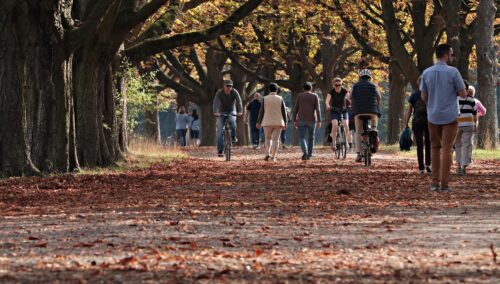Image courtesy of Pixabay.
On a typical walk through New York City, you might expect to encounter tall, glass-covered skyscrapers, brightly lit department stores, and concrete sidewalks. But what about a forest? While the term “urban forest” may seem like an oxymoron, it describes any park, forested natural area, or collection of street trees within a city or suburban space. These forests provide essential habitats for regional wildlife and improve air quality by capturing carbon dioxide. Additionally, they serve as models of the effects of human development and pollution on nature. Despite their importance to a large proportion of the US population, urban forests have been historically understudied.
A prime example of an urban forested natural area is the Thain Family Forest (TFF) in the Bronx, New York. This nearly fifty-acre native forest has survived centuries of regional colonization, urbanization, and fragmentation, making it a rare instance of an urban forest in the Northeast, where most existing forests were once cleared for agriculture and have since regrown. The TFF has been studied by the New York Botanical Garden since 1895, allowing for a multitude of ecological data to be collected over time. Recently, researchers at the Yale Forestry School and the New York Botanical Garden analyzed data collected at the TFF between 1937 and 2021. They found that while the structure of the forest canopy has not changed much over time, the species composition has experienced drastic alterations. Much of these changes occurred after the decline of eastern hemlock trees—a species of evergreen that formerly covered most of the TFF.
The eastern hemlock was once a foundational species of forests in the northeastern US, but in the 1980s, the population was devastated by the introduction of an invasive pest—the hemlock woolly adelgid. “Regionally, we know when hemlock woolly adelgid was introduced, we saw a significant loss of hemlock in this entire region,” said Eliot Nagele, the New Jersey Director of Lands at The Nature Conservancy (TNC). Nagele began this research as a student at the Yale Forestry School and later served as Director of the TFF. “The concern in the ’80s was that hemlock loss would result in a decrease in understory shade and an increase in the temperature of streams and rivers,” Nagele said. These changes in forest species composition can affect the forests’ suitability as habitats for native wildlife, impacting the ecosystem as a whole. Hemlock woolly adelgid is still spreading through eastern hemlock populations in places such as upstate New York, potentially leading to vital species loss. Since invasive species are often first identified in cities, a better understanding of their impact on urban forests will allow researchers to identify appropriate management practices before they spread to larger rural forests.
Since the mid-1980s, the TFF has implemented adaptive management strategies to reduce human impacts, such as delineating forest paths to limit foot traffic and collecting data to monitor forest health and guide future management. The study also found that since these conservation efforts began, species diversity in the forest has increased. Both native and non-native species were able to fill in the gaps left by the hemlock’s decline, maintaining a densely populated forest. Additionally, they found that over the last century, the forest had continued to be predominantly composed of native species. “What we’re showing in this system is that if you can maintain the health of the system and manage invasive species at the same time, you can actually allow for the regeneration of a healthy native-species-dominant forest,” Nagele said.
Nearly one hundred years of evidence support the efficacy of TFF’s adaptive management system in maintaining native species. Thus, the lack of urban forest research compared to rural research may be a barrier to developing effective management tactics. “I think the most important thing is that we, as a forestry community, scientific community, and college community, start to break down and get rid of the artificial divisions between urban and rural,” Nagele said. Although complete biodiversity in urban forests cannot be restored overnight, applying management efforts like those established in the TFF to urban forests across the US can facilitate more effective regeneration. Additionally, citizen volunteers can help collect data for urban forest managers, showing that no matter where you live, you can contribute to your area’s native environment. So, the next time you visit a city, know that between the buildings, parking lots, and bus stops, there is a whole world of biodiversity waiting for you.
[Citations]
Examining a Century of Change in a New York City Urban Forest. Yale School of the
Environment. (2024). https://environment.yale.edu/news/article/examining
-century-change-new-york-city-urban-forest
Nagele, E., Ashton, M. S., Harris, T. B., Forrest, T. A., DeLuca, E. A., Martello, M. E., &
Duguid, M. C. (2024). A Century of Change in a Mature Urban Forest: The
Thain Family Forest of the New York Botanical Garden, Bronx, New York. Journal of Forestry. https://doi.org/10.1093/jofore/fvad057
Urban forests. US Forest Service. (n.d.-b). https://www.fs.usda.gov/managing-land/urban-forests
U.S. Department of the Interior. (n.d.). Eastern Hemlock. National Parks Service.
https://www.nps.gov/shen/learn/nature/eastern_hemlock.htm

